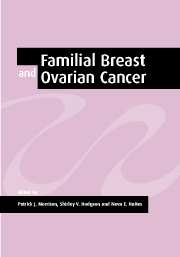Book contents
- Frontmatter
- Contents
- List of contributors
- Foreword by Helena Kennedy
- Preface
- Acknowledgements
- Part 1 Molecular biology and natural history
- Part 2 Screening
- Part 3 Management
- 15 Management of BRCA1/2 mutation carriers
- 16 Management of familial ovarian cancer
- 17 Prophylactic mastectomy in mutation carriers
- 18 Psychosocial aspects of genetic counselling for breast and ovarian cancer
- 19 BRCA1/2 testing: uptake and its measurement
- 20 Breast cancer genetics: ethical, social and insurance issues
- 21 Gene therapy for breast and ovarian cancer
- 22 Future directions
- Index
18 - Psychosocial aspects of genetic counselling for breast and ovarian cancer
Published online by Cambridge University Press: 24 August 2009
- Frontmatter
- Contents
- List of contributors
- Foreword by Helena Kennedy
- Preface
- Acknowledgements
- Part 1 Molecular biology and natural history
- Part 2 Screening
- Part 3 Management
- 15 Management of BRCA1/2 mutation carriers
- 16 Management of familial ovarian cancer
- 17 Prophylactic mastectomy in mutation carriers
- 18 Psychosocial aspects of genetic counselling for breast and ovarian cancer
- 19 BRCA1/2 testing: uptake and its measurement
- 20 Breast cancer genetics: ethical, social and insurance issues
- 21 Gene therapy for breast and ovarian cancer
- 22 Future directions
- Index
Summary
Introduction
The population risk of developing breast cancer in the UK is 1 in 12 and the risk of ovarian cancer is 1 in 100. A small proportion (approximately 5–10%) of women who develop breast and ovarian cancers have an inherited genetic susceptibility to these cancers (Easton and Peto, 1990; Claus et al., 1991). To date, two breast and ovarian cancer predisposing genes have been identified: BRCA1 (Miki et al., 1994; Easton et al., 1995; Narod et al., 1995) and BRCA2 (Wooster et al., 1995). Women who have inherited a mutation in the BRCA1 or BRCA2 gene have approximately an 80% risk of developing breast cancer over their lifetime, particularly at a young age, and a 40%–60% lifetime risk of developing ovarian cancer (Easton et al., 1995).
Widespread publicity about the possible genetic basis of some breast and ovarian cancers has led to an increase in concern amongst women with a family history of these cancers. Increasing numbers of women are attending clinics in hospitals in the UK for genetic counselling about their family history of breast or ovarian cancer, where most will want information about their future risk of developing cancer (Brain et al., 2000a) and about what steps they can take to minimize this risk. A further motivation for attending for genetic counselling is to undergo genetic testing. Both risk counselling and genetic testing have psychosocial effects.
- Type
- Chapter
- Information
- Familial Breast and Ovarian CancerGenetics, Screening and Management, pp. 295 - 305Publisher: Cambridge University PressPrint publication year: 2002



